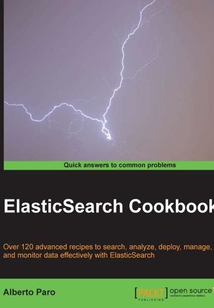舉報 

會員
ElasticSearch Cookbook
最新章節:
Index
Writteninanengaging,easy-to-followstyle,therecipeswillhelpyoutoextendthecapabilitiesofElasticSearchtomanageyourdataeffectively.IfyouareadeveloperwhoimplementsElasticSearchinyourwebapplications,managedata,orhavedecidedtostartusingElasticSearch,thisbookisidealforyou.Thisbookassumesthatyou’vegotworkingknowledgeofJSONandJava
目錄(163章)
倒序
- coverpage
- ElasticSearch Cookbook
- Credits
- About the Author
- About the Reviewers
- www.PacktPub.com
- Support files eBooks discount offers and more
- Preface
- What this book covers
- What you need for this book
- Who this book is for
- Conventions
- Reader feedback
- Customer support
- Chapter 1. Getting Started
- Introduction
- Understanding node and cluster
- Understanding node services
- Managing your data
- Understanding cluster replication and sharding
- Communicating with ElasticSearch
- Using the HTTP protocol
- Using the Native protocol
- Using the Thrift protocol
- Chapter 2. Downloading and Setting Up ElasticSearch
- Introduction
- Downloading and installing ElasticSearch
- Networking setup
- Setting up a node
- Setting up ElasticSearch for Linux systems (advanced)
- Setting up different node types (advanced)
- Installing a plugin
- Installing a plugin manually
- Removing a plugin
- Changing logging settings (advanced)
- Chapter 3. Managing Mapping
- Introduction
- Using explicit mapping creation
- Mapping base types
- Mapping arrays
- Mapping an object
- Mapping a document
- Using dynamic templates in document mapping
- Managing nested objects
- Managing a child document
- Mapping a multifield
- Mapping a GeoPoint field
- Mapping a GeoShape field
- Mapping an IP field
- Mapping an attachment field
- Adding generic data to mapping
- Mapping different analyzers
- Chapter 4. Standard Operations
- Introduction
- Creating an index
- Deleting an index
- Opening/closing an index
- Putting a mapping in an index
- Getting a mapping
- Deleting a mapping
- Refreshing an index
- Flushing an index
- Optimizing an index
- Checking if an index or type exists
- Managing index settings
- Using index aliases
- Indexing a document
- Getting a document
- Deleting a document
- Updating a document
- Speeding up atomic operations (bulk)
- Speeding up GET
- Chapter 5. Search Queries and Filters
- Introduction
- Executing a search
- Sorting a search
- Highlighting results
- Executing a scan query
- Suggesting a correct query
- Counting
- Deleting by query
- Matching all the documents
- Querying/filtering for term
- Querying/filtering for terms
- Using a prefix query/filter
- Using a Boolean query/filter
- Using a range query/filter
- Using span queries
- Using the match query
- Using the IDS query/filter
- Using the has_child query/filter
- Using the top_children query
- Using the has_parent query/filter
- Using a regexp query/filter
- Using exists and missing filters
- Using and/or/not filters
- Using the geo_bounding_box filter
- Using the geo_polygon filter
- Using the geo_distance filter
- Chapter 6. Facets
- Introduction
- Executing facets
- Executing terms facets
- Executing range facets
- Executing histogram facets
- Executing date histogram facets
- Executing filter/query facets
- Executing statistical facets
- Executing term statistical facets
- Executing geo distance facets
- Chapter 7. Scripting
- Introduction
- Installing additional script plugins
- Sorting using script
- Computing return fields with scripting
- Filtering a search via scripting
- Updating with scripting
- Chapter 8. Rivers
- Introduction
- Managing a river
- Using the CouchDB river
- Using the MongoDB river
- Using the RabbitMQ river
- Using the JDBC river
- Using the Twitter river
- Chapter 9. Cluster and Nodes Monitoring
- Introduction
- Controlling cluster health via API
- Controlling cluster state via API
- Getting nodes information via API
- Getting node statistic via API
- Installing and using BigDesk
- Installing and using ElasticSerach-head
- Installing and using SemaText SPM
- Chapter 10. Java Integration
- Introduction
- Creating an HTTP client
- Creating a native client
- Managing indices with the native client
- Managing mappings
- Managing documents
- Managing bulk action
- Creating a query
- Executing a standard search
- Executing a facet search
- Executing a scroll/scan search
- Chapter 11. Python Integration
- Introduction
- Creating a client
- Managing indices
- Managing mappings
- Managing documents
- Executing a standard search
- Executing a facet search
- Chapter 12. Plugin Development
- Introduction
- Creating a site plugin
- Creating a simple plugin
- Creating a REST plugin
- Creating a cluster action
- Creating an analyzer plugin
- Creating a river plugin
- Index 更新時間:2021-04-02 10:10:30
推薦閱讀
- Linux設備驅動開發詳解(第2版)
- Ubuntu Linux操作系統
- Installing and Configuring Windows 10:70-698 Exam Guide
- macOS效率手冊
- Java EE 8 Design Patterns and Best Practices
- Docker+Kubernetes應用開發與快速上云
- 蘋果OS X Mavericks 10.9應用大全
- Django Project Blueprints
- Linux基礎使用與案例
- Troubleshooting Docker
- Advanced Infrastructure Penetration Testing
- Heroku Cloud Application Development
- Docker for Developers
- HarmonyOS應用開發:快速入門與項目實戰
- 庖丁解牛Linux操作系統分析
- 自研操作系統:DIM-SUM設計與實現
- 精通Linux內核:智能設備開發核心技術
- Azure DevOps Server 2019 Cookbook(Second Edition)
- 嵌入式操作系統(Linux篇)
- 計算機應用基礎(Windows 7+Office 2016)上機指導與習題集
- Mastering Bootstrap 4(Second Edition)
- DevOps with Windows Server 2016
- Windows PowerShell實戰指南(第3版)
- Windows8應用開發實戰:使用JavaScript
- 電腦辦公從入門到精通(Windows 7+Office 2013版)
- Docker容器技術與高可用實戰
- 蛻變:從菜鳥到Linux安全專家
- Learning Continuous Integration with Jenkins
- 第一行代碼:Android(第2版)
- Linux內核探秘:深入解析文件系統和設備驅動的架構與設計

